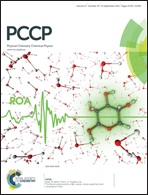Mechanisms and dynamics of protonation and lithiation of ferrocene†
Abstract
By elucidating the mechanism of the simplest electrophilic substitution reaction of ferrocene, it was found that the verification of the protonation reaction has been a difficulty. In the work reported here, ab initio chemical dynamics simulations were performed at B3LYP/DZVP level of theory to understand the atomic level mechanisms of protonation and lithiation of ferrocene. Protonation of ferrocene resulted in the agostic and metal-protonated forms. Trajectory calculations revealed that protonation of ferrocene occurs by exo and endo mechanisms, with exo being the major path. H+ was found to be mobile and hopped from the Cp ring to the metal center and vice versa after the initial attack on ferrocene, with the metal-complex having a shorter lifetime. These results remove the ambiguity surrounding the mechanism, as proposed in earlier experimental and computational studies. Lithiation of ferrocene resulted in the formation of cation–π and metal-lithiated complexes. Similar to protonation, trajectory results revealed that both exo and endo paths were followed, with the exo path being the major one. In addition, lithiated-ferrocene exhibited planetary motion. The major path (exo) followed in the protonation and lithiation of ferrocene is consistent with the observations in earlier experimental studies for other hard electrophiles.


 Please wait while we load your content...
Please wait while we load your content...